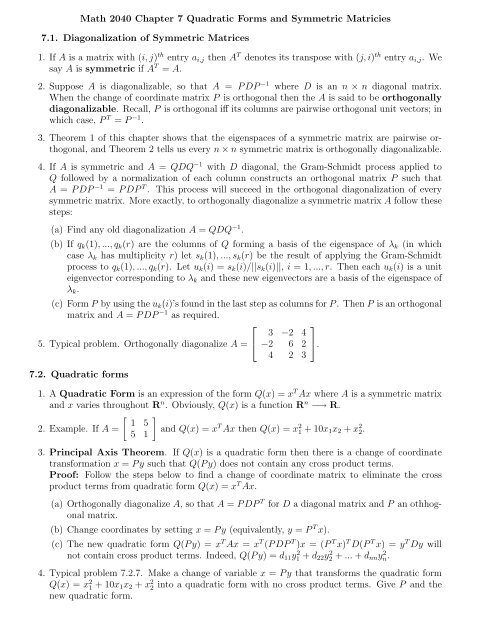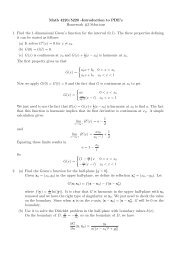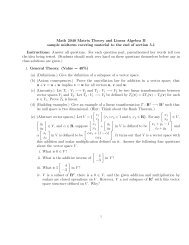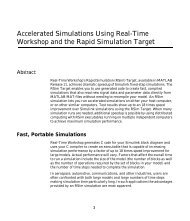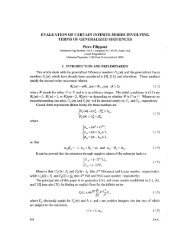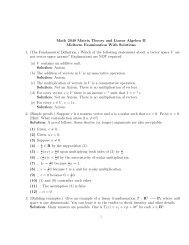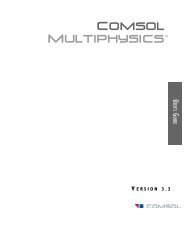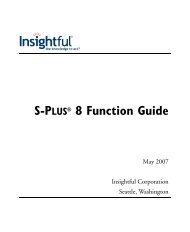Math 2040 Chapter 7 Quadratic Forms and Symmetric Matricies 7.1 ...
Math 2040 Chapter 7 Quadratic Forms and Symmetric Matricies 7.1 ...
Math 2040 Chapter 7 Quadratic Forms and Symmetric Matricies 7.1 ...
You also want an ePaper? Increase the reach of your titles
YUMPU automatically turns print PDFs into web optimized ePapers that Google loves.
<strong>Math</strong> <strong>2040</strong> <strong>Chapter</strong> 7 <strong>Quadratic</strong> <strong>Forms</strong> <strong>and</strong> <strong>Symmetric</strong> <strong>Matricies</strong><br />
<strong>7.1</strong>. Diagonalization of <strong>Symmetric</strong> Matrices<br />
1. If A is a matrix with (i, j) th entry a i,j then A T denotes its transpose with (j, i) th entry a i,j . We<br />
say A is symmetric if A T = A.<br />
2. Suppose A is diagonalizable, so that A = P DP −1 where D is an n × n diagonal matrix.<br />
When the change of coordinate matrix P is orthogonal then the A is said to be orthogonally<br />
diagonalizable. Recall, P is orthogonal iff its columns are pairwise orthogonal unit vectors; in<br />
which case, P T = P −1 .<br />
3. Theorem 1 of this chapter shows that the eigenspaces of a symmetric matrix are pairwise orthogonal,<br />
<strong>and</strong> Theorem 2 tells us every n × n symmetric matrix is orthogonally diagonalizable.<br />
4. If A is symmetric <strong>and</strong> A = QDQ −1 with D diagonal, the Gram-Schmidt process applied to<br />
Q followed by a normalization of each column constructs an orthogonal matrix P such that<br />
A = P DP −1 = P DP T . This process will succeed in the orthogonal diagonalization of every<br />
symmetric matrix. More exactly, to orthogonally diagonalize a symmetric matrix A follow these<br />
steps:<br />
(a) Find any old diagonalization A = QDQ −1 .<br />
(b) If q k (1), ..., q k (r) are the columns of Q forming a basis of the eigenspace of λ k (in which<br />
case λ k has multiplicity r) let s k (1), ..., s k (r) be the result of applying the Gram-Schmidt<br />
process to q k (1), ..., q k (r). Let u k (i) = s k (i)/||s k (i)||, i = 1, ..., r. Then each u k (i) is a unit<br />
eigenvector corresponding to λ k <strong>and</strong> these new eigenvectors are a basis of the eigenspace of<br />
λ k .<br />
(c) Form P by using the u k (i)’s found in the last step as columns for P . Then P is an orthogonal<br />
matrix <strong>and</strong> A = P DP −1 as required.<br />
⎡<br />
5. Typical problem. Orthogonally diagonalize A = ⎣ 3 −2 4<br />
⎤<br />
−2 6 2 ⎦.<br />
4 2 3<br />
7.2. <strong>Quadratic</strong> forms<br />
1. A <strong>Quadratic</strong> Form is an expression of the form Q(x) = x T Ax where A is a symmetric matrix<br />
<strong>and</strong> x varies throughout R n . Obviously, Q(x) is a function R n −→ R.<br />
[ ]<br />
1 5<br />
2. Example. If A = <strong>and</strong> Q(x) = x<br />
5 1<br />
T Ax then Q(x) = x 2 1 + 10x 1 x 2 + x 2 2.<br />
3. Principal Axis Theorem. If Q(x) is a quadratic form then there is a change of coordinate<br />
transformation x = P y such that Q(P y) does not contain any cross product terms.<br />
Proof: Follow the steps below to find a change of coordinate matrix to eliminate the cross<br />
product terms from quadratic form Q(x) = x T Ax.<br />
(a) Orthogonally diagonalize A, so that A = P DP T for D a diagonal matrix <strong>and</strong> P an othhogonal<br />
matrix.<br />
(b) Change coordinates by setting x = P y (equivalently, y = P T x).<br />
(c) The new quadratic form Q(P y) = x T Ax = x T (P DP T )x = (P T x) T D(P T x) = y T Dy will<br />
not contain cross product terms. Indeed, Q(P y) = d 11 y 2 1 + d 22 y 2 2 + ... + d nn y 2 n.<br />
4. Typical problem 7.2.7. Make a change of variable x = P y that transforms the quadratic form<br />
Q(x) = x 2 1 + 10x 1 x 2 + x 2 2 into a quadratic form with no cross product terms. Give P <strong>and</strong> the<br />
new quadratic form.
7.3. Constrained Optimization<br />
1. The unit sphere in R n is S n−1 = {x | ||x|| = 1}. ||x|| 2 = x T x, so S n−1 = {x | x T x = 1}.<br />
2. Theorem 6. (page 465 <strong>and</strong> 466) Q(x) = x T Ax be a quadratic form such that A is a symmetric<br />
n × n matrix. Let M <strong>and</strong> m be the respective maximum (largest) <strong>and</strong> minimum (least, possibly<br />
negative) values of Q(x) on S n−1 . Then M <strong>and</strong> m are the maximum <strong>and</strong> minimum eigenvalues<br />
of A, respectively. Q(x) = M (respectively, Q(x) = m) at a unit eigenvector corresponding to<br />
M (respectively, at a unit eigenvector corresponding to m).<br />
3. Typical problem. Find the maximum value of Q(x) = x 2 1 + 10x 1 x 2 + x 2 2 subject to the constraint<br />
x 2 1 + x 2 2 = 1.


